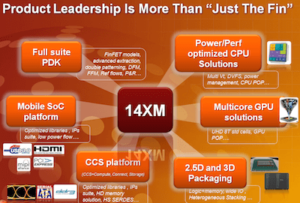I always hesitate to cove 3D transistors, because before they came along, I only focused on what I knew to be 3D – ie: 3D stacked packages, 2.5D interposers and 3D ICs. And that was confusing enough. But then along came Intel’s Tri-Gate technology, claiming the 3D moniker as its own, launching into production at warp speed, and immediately confused industry journalists, who began to compare apples (3D transistors) to oranges (3D ICs.) So I’ve decided that while welcoming 3D transistors into the 3D InCites radar, I must be sure to keep things separate.
As it happens, today there were a number of posts today in the blogosphere about 3D transistors, also known as Tri-Gate (Intel’s technology) FinFETS ( industry generic term) and now GlobalFoundries’ 14XM, so called because it’s a 14nm process built for extreme mobility, which was just announced today. Here’s the general low-down reported on EDA Café.
In a post on “The Foundry Files” GlobalFoundries’ corporate blog titled Architecting Advanced Technologies: Not All FinFETs are Created Equal, CTO Greg Bartlett talks about how at 20nm and beyond there’s been a major market driver shift from GPUs and CPUs to Mobile SoCs, and as such it’s not about cramming as many transistors on a piece of silicon any more. There are other things to be considered. “Mobile SoCs require a delicate balance between performance and power consumption, while minimizing both die size and cost.” He writes, and adds “…consideration needs to be given to SoC-level concerns beyond the transistor architecture, such as overall system-level performance and specific mobile applications needs.”
GlobalFoundries answer: 14XM based on a modular technology architecture that uses a 14nm FinFET device combined with elements of the company’s 20nm-LPM process. The goal is to provide a whole product solution “from the transistor all the way up to the system level.” (And look: according to the figure below, 2.5D and 3D packaging is part of the system).

In his post on Semi Wiki covering the announcement, GlobalFoundries Announces 14nm Process blogger Paul McClellen notes that with this product, GlobalFoundries is trying to match Intel’s time line for introducing 14nm technology. He also points out that 14XM is really a hybrid because even though the transistor is a 14nm FinFET, the remainder of the processes are standard 20nm with the same metal pitches. Regardless, it still achieves a reported 40-60% improvement in battery life. Paul has a lot more to say on the topic, so you should really read his full post.
While we’re on the topic of FinFETS, I came across a blog post featured in the GSA’s newsletter that came out today, written by Nick Kepler of SuVolta. In How Power Consumption and Cost Impact Moore’s Law and More-than-Moore Roadmaps, Kepler proposes “that the semiconductor process technology roadmap should now be split in two: a roadmap with the classical “Moore’s Law” benefit of greater density from shrinking, and a “More-than-Moore” roadmap that enhances the capability of a given process technology by reducing power consumption.” The solution is for the industry to move from conventional planar bulk transistor technologies to those based on depleted channel technologies that can be 3D such as FinFETS, planar on silicon-on-insulator wafers (such as FD-SOI), or planar on bulk silicon wafers (e.g., the Deeply Depleted Channel technology). The article offers comprehensive details on all three, and is worth the read if you’re interested in learning more.
Tim Robson, of SOITEC, also gets on the fully depleted soapbox with his article (also published in the GSA newsletter) The Race to Fully Depleted Devices. He talks a lot about Intel’s bravado over being first in FinFets with its TriGate transistor: “The company is so confident in its technological prowess that it is practically taunting the rest of the industry to try and put FinFET into production” and what it means for the the Intel vs. ARM debate. He also addresses fabless options for access to a fully-depleted device, and notes that “When the rest of the semiconductor industry gets access to its first fully depleted FinFET device from a pure play foundry, Intel will be on its third incarnation of its Tri-Gate process.” The concluding message to pure play foundries and fabless: Fully Depleted Devices — if you don’t have one get one! Sure looks like GlobalFoundries got the message. ~F.v.T.

















